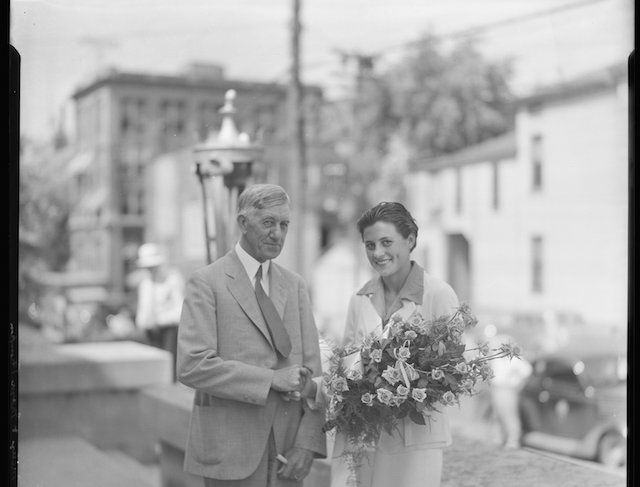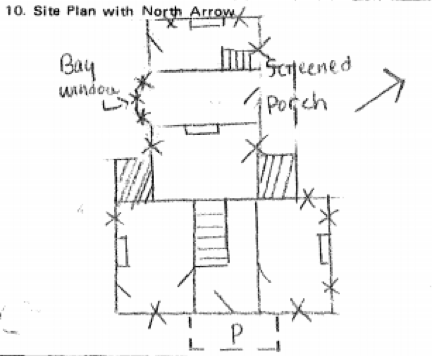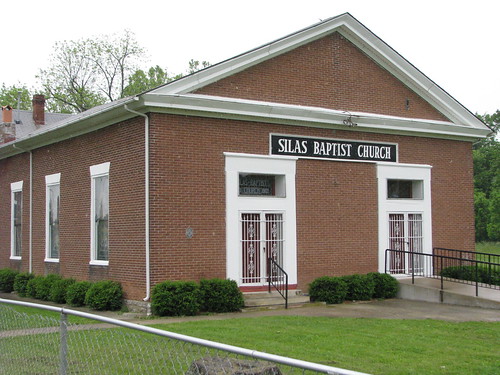 |
| 333 East Short Street in Lexington, Kentucky was once home to Good Samaritan Hospital. Author’s collection. |
The Women’s Guild of Christ Church Episcopal Church established in 1888 an infirmary for the care of Lexingtonians.It would be Lexington’s second hospital, St. Joseph having been established by Catholic Church in 1877.
The mission began in Farmer Dewees’ ca. 1814 White Cottage located on East Short Street which the Guild purchased for $5,000 from Bernard Fotch. The cottage had been home in the late 1830s to H.H. Gratz, the editor of the Kentucky Gazette; it was ultimately torn down in 1940.
 |
| The 1890 Sanborn Map of Lexington shows the White Cottage and the adjacent Infirmary. UK Libraries. |
 |
| The Dewees House on East Short Street, ca. 1907. UK Libraries. |
Good Samaritan Hospital
According to the Herald-Leader, which published a history of the medical facility on the occasion of its golden anniversary, the physical plant of the infirmary cost just under $40,000. Although no records exist from 1888, 1889 witnessed some 659 patients being treated here. The operating budget in that year for the infirmary was just over $11,000.
Also in January 1889, the Episcopal Women’s Guild transferred control of the infirmary to a consortium of Protestant churches of the Baptist, Christian, Episcopal, Methodist, and Presbyterian faiths. A decade later, in 1899, the Protestant Infirmary was also renamed as the Good Samaritan Hospital.
Realizing the need for nurses, a nursing school was established at the hospital and the first class of nurses graduated in 1893. In perhaps an unrelated note, an effort was made “to get [the] red light district moved away from neighborhood of Protestant Infirmary” according to the Morning Transcript in August 1894. (Belle Brezing’s infamous bordello was only a one-and-a-half blocks away at 59 Megowan which is now the corner of Wilson Street and Eastern Avenue).
Additions and annexes to the facility were constructed on multiple occasions, including those in 1895 and 1897. Below shows the Good Samaritan Hospital as it appears on the 1907 Sanborn map, including an operating room, laundry building, colored ward, and morgue.
 |
| 1907 Sanborn map of Lexington depicting Good Samaritan Hospital. UK Libraries |
To Be Vacated
At the bottom of the 1907 Sanborn is a notation that the buildings of Good Samaritan Hospital are “to be vacated in the near future.” Plans had developed in 1905 for a new and modern medical facility which purchased land at 310 South Limestone Street from W. H. McCorkle. The site had once been part of the James O. Harrison estate, with Mr. Harrison having passed away in his home on the site in 1888.
Mr. Harrison was a prominent citizen and early leader in Lexington’s local school system (for him, Harrison Elementary is named). His daughter, Mary Eliza, was a member of the Women’s Guild which helped establish the Protestant Infirmary in the first place.
In 1907, the Good Samaritan Hospital relocated to its new 130-bed hospital. In 1924, the Methodist Church took exclusive control of Good Samaritan. It would change hands several more times during the 20th century. In 2007, Samaritan Hospital filed for Chapter 11 bankruptcy relief and the University of Kentucky Healthcare system purchased the medical facility during the bankruptcy.
Coffee Times
But the structure on East Short Street remained standing. A public sale of the structure in 1920 brought it into the hands of W.T. Woolfolk whose Woolkfolk Coffee Company thereafter called it home. The coffee company had previously been located on Vine Street between Upper and Mill.
 |
| Nota Bene: Keep Peanuts Off the Floor Signage at 333 East Short. Author’s collection. |
Remembrances of the coffee days can be found around the building with stampings of the Greenbag Coffee on the walls. Too, are advices to keep peanuts off the floor.
Of Mr. Woolfolk, this was written in the Lexington Leader preceding a 1905 election: “William T. Woolfolk, of the wholesale grocery firm of Martin & Woolfolk, corner of Mill and Market streets, is the Republican candidate for member of the Lower Board of the City Council in the First Ward. Mr. Woolfolk was born and reared in Garrard County, Ky., and came to Lexington about fifteen years ago, engaging in the retail grocery business at High and Broadway.”
Wool folk’s coffee and peanut operation ended near the start of World War II, according to news reports. This was no doubt due to the federal policy of coffee rationing which began in 1942.
A New Role
Since World War II, the old Protestant Infirmary has been the home of Hurst Office Supply. In 2014, the structure was acquired at public sale by Zeff Maloney through one of his businesses. Since, he has gone through a paintstaking process of bringing beauty back to this nineteenth century structure and adapting it for modern use.
Now the structure is rented to various commercial interests including a spa, insurance offices, and law offices. In the process of restoration, Maloney extracted some ten tons of plaster from the building which had covered the beautiful interior brick.
Interested in seeing this awesome place? Join the #BGTdeTours which is hosting a tour of 333 East Third Street on November 4, 2015 beginning at 5:30 p.m. Details about this event are available on Facebook. And if you can’t make it, come visit one of the businesses that now call the old Protestant Infirmary home.
 |
Remaining plaster indicates the intensive process of removing it.
Author’s collection. |
































